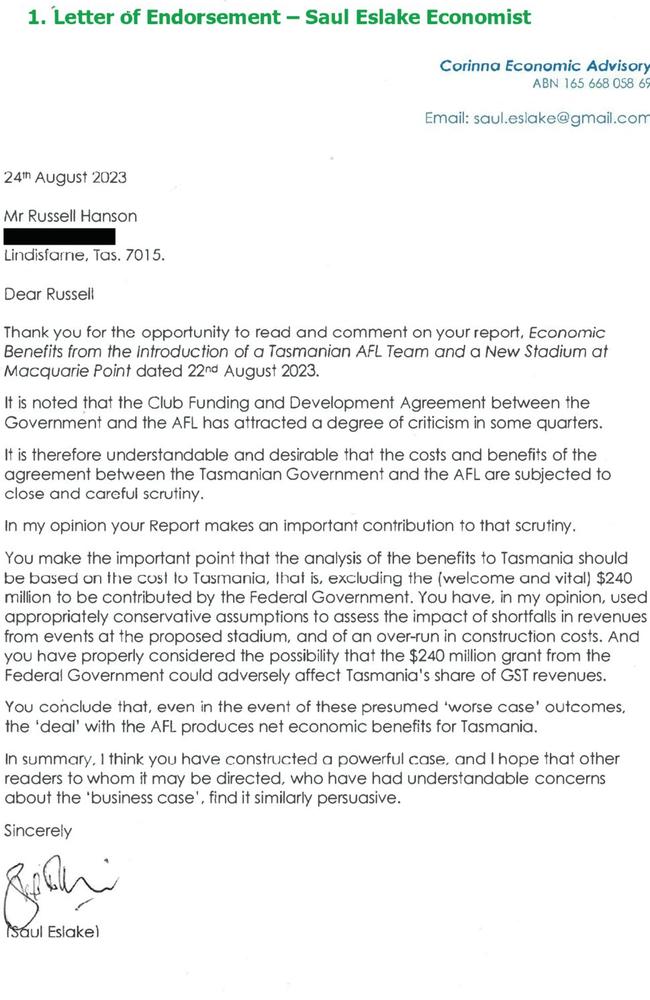The Macquarie Point stadium report that turbo-charges the Yes Stadium campaign
An explosive report on the economic benefits of the Mac Pt Stadium says it would be a gold mine and rival MONA as a landmark attraction. Read why it’s going to make waves for the ‘no’ camp.

Tasmania
Don't miss out on the headlines from Tasmania. Followed categories will be added to My News.
A NEW report into the economic benefits of Macquarie Point Stadium says it would be an intergenerational gold mine for the state’s economy and rival MONA as a landmark attraction and magnet for visitors and events.
Backed by renowned Australian economist, Saul Eslake, the report found Macquarie Point would generate $226.61m a year in economic benefits for Tasmania, adding up to an eye-watering $2.26 billion boost in its first 10 years.
In a glowing assessment of the analysis, Eslake called it a “powerful case” and hoped all interested parties, particularly the stadium naysayers, would find it a compelling indicator of what a bespoke 23,000-seat roofed stadium at Macquarie Point could achieve.
Pro-stadium interests say the report blows a hole in the side of the “no ship”.

Even under the worst case scenario, it says Macquarie Point stadium would generate a total of $169.96m per year, calculated using all of the “common negative claims by the naysayers”.
“You have constructed a powerful case and I hope that other readers to whom it may be directed, who have understandable concerns about the business case, find it similarly persuasive,” Eslake said.
The report is authored by Tasmanian Russell Hanson, former Finance Director of FitzGerald’s Department Stores, CEO of the National body of The Wilderness Society and Managing Director Co-Operative Motors.
Hanson is credited as the man who rescued the Wilderness Society from the brink of bankruptcy in the 1990s and was awarded the Centenary Medal for doing so.
The $226.61m economic boost found in the Hanson Report was derived using the same cost benefit analysis methodology used by PricewaterhouseCoopers to calculate the economic benefits generated by Hawthorn AFL games at UTAS Stadium in Launceston, a methodology accepted by both the state government and Labor Opposition.

Using the exact PwC methodology, which all parties have long accepted to support the Hawthorn games at Launceston, it finds a $29.62m per annum benefit to the state’s economy, and for the Mac Point stadium, a whopping $226.61m per annum.
Hanson says: “Opponents cannot accept PwC to justify the Hawthorn spend, and then ignore it when it comes to Mac Point.”

The Hanson Report, titled Economic Benefits to Tasmania from the Introduction of a Tasmanian AFL Team and a New Stadium in Hobart at Macquarie Point, debunks claims the stadium would be a financial burden.
“It is quite clear the economic benefits to this state are every bit as compelling as the vitally-important and unquestioned social, health and wellbeing benefits,” Mr Hanson says in the report.
“Even when a worst-case scenario is looked at, with direct benefits substantially discounted, the new Stadium is no ‘dud’.
“It is not a 20-year loss of $306.2m, as has been claimed, it will generate additional visitation spend across the whole state in excess of $2 billion over the 20 years.
“This huge economic benefit is further demonstrated on examination of the PwC analysis of the Hawthorn games in Launceston and applying the same methodology to the new Stadium, the economic returns are substantially positive, ongoing and an opportunity this state can’t afford to lose.”
Macquarie Point stadium is set to cost $715m _ $240m in Federal Funding announced by Prime Minister Anthony Albanese in Hobart on April 29, $15m from the AFL, $85m from land sales and leasing and naming rights, and the $375m balance from the state government.
MI Global uses the total cost of the stadium in its calculations, but from Tasmania’s perspective the cost is what the state puts in: $375m.
That alone changes the MI Global loss of $306.2m to a loss of $61.8 million (a $244.m turnaround) and this is before other benefits, that have previously not been included, are factored in.
Hanson says: “Intrastate incremental expenditure that would occur from Tasmanians utilising hospitality, tourism, goods and services associated with their attendance and use of the stadium precinct with a wide range of new events that previously required travel to the mainland to achieve their objectives. This represents $4.76 million per annum in real terms.”
Jobs and activity generated by construction of the stadium precinct add up to $14.5m, and activities created by the operation of the Tasmanian AFL and AFLW teams will produce $10.62m each year.
With all the benefits included, the discounted Net Benefits would be $527.9 million over 20 years.
“Even if you stress-test the calculation by allowing for cost blow outs, fewer events, combined with funds deducted from GST, and less flow-on benefits, we still end up with a profit of $54.30m,” he said.
Mr Hanson addresses “the question raised as to how the state would manage the increased debt associated with the $375 million contribution to the stadium as compared to spending the $375m on health”.
“The stadium would be generating economic activity from day one, opening the door to principal repayment and interest over a 20-year period, versus spending the $375m on health with no economic return and hence compounding interest over 20 years,” he said.
In layman’s terms, that means the stadium will make money, whereas adding an extra $375m to the health budget each year worsens state debt.
The Hanson report says: “The 2023-24 Budget for Tasmania shows the estimated health spend over four years will be $12.1 billion, or $8.3 million each and every day. The new stadium cost to Tasmania represents just 45 days of health spend over the same period.”
As owner of Macquarie Point stadium, the state government would have additional earnings to boost health and public housing spending, as well as other essential services.
The report also draws attention to the $130m in Federal funding being tipped into UTAS Stadium in Launceston and alludes to the long-accepted political battleground in the state’s north.
“It is ironic that there is criticism of the health spend and claims that a New Stadium is the wrong priority, yet there are no issues with the $130m currently being spent on York Park, for which there has been no rigorous examination at all, as compared to what is happening with the New Stadium; also, this expenditure is based on getting a Tasmania team which is currently under threat by opponents of the New Stadium,” Hanson says in the report.





